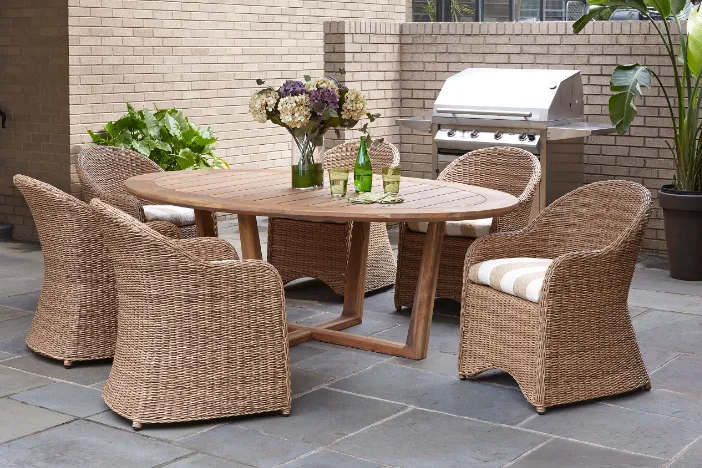
While wood and metals are classic outdoor furniture materials, man-made synthetic materials, such as resin and plastic, are becoming more and more prevalent. Synthetics are typically lightweight, inexpensive and can be molded into any decor style imaginable. Because color is inherent in the chemical makeup, they are fade-resistant and don’t require paint or sealants used by other materials. They’re also a breeze to clean and maintain.
With so many benefits, it is easy to see why these alternative materials are becoming more popular. There is a growing number of plastics and resins, but here are a few of the more common ones currently in use.
Plastic vs Resin Outdoor Furniture
New manufacturing processes and hybrid compositions enable these polymers to take on shapes and sizes previously unattainable. Two popular materials often come into consideration: plastic and resin.
Both manufactured materials offer unique benefits, especially when it comes to affordability and style.
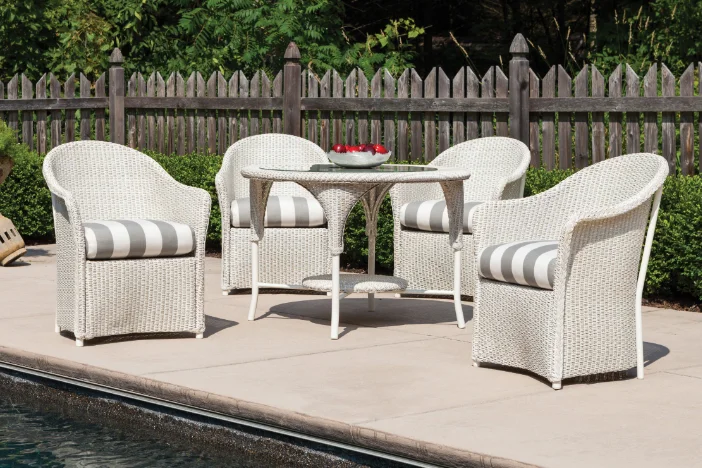
Synthetic Resin – All-Weather Wicker
Virtually all outdoor wicker furniture is made from synthetic polyethylene resin. Natural wicker is made from a variety of organic sources such as rattan, seagrass, bamboo, banana leaf and even willow. While strong and aesthetically pleasing, plant-based wicker is susceptible to damage from rainy weather, moisture and humidity – a poor material choice for outdoor chairs, sofas and coffee tables.
On the other hand, resin is good for the outdoors. High-quality resin is very dense, resistant to weather damage and eco-friendly. High-density polyethylene (HDPE) does not emit any chemicals, is highly puncture resistant and can be exposed to UV rays for decades without experiencing any degradation [Topliff 2018]. Synthetic all-weather synthetic resin is weatherproof, lightweight, fade-resistant and easy to clean.
There are lower-quality synthetic wickers made from polyvinyl chloride (PVC), which tends to become brittle and crack over time. Most outdoor wicker patio furniture is constructed over an aluminum frame, which increases the weight it can support. Synthetic wicker can be colored an organic shade, making it virtually indistinguishable from natural wicker. It can also be given a vibrant tone that adds a pop of color to your lanai or hardwood deck.
PROS
- Extremely weather-resistant
- Easy-to-clean
- It can look like natural wicker
- HDPE wicker is 100% recyclable
CONS
- Not heavy enough for many windy environments
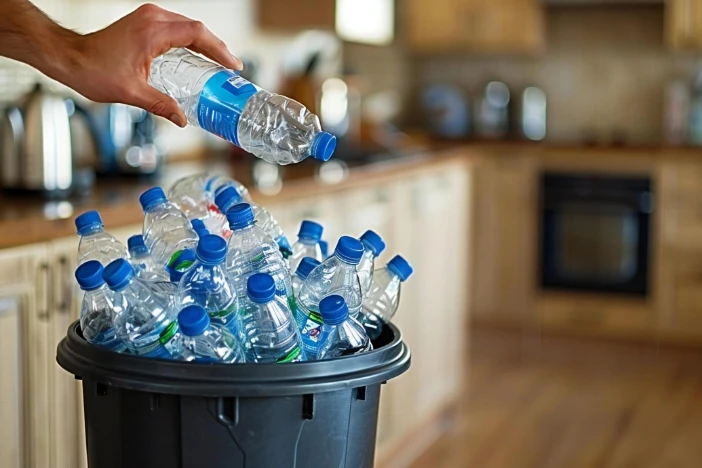
Recycled Plastic
Another plastic material for outdoor furniture that is more eco-friendly is recycled plastic (i.e. made from milk cartons, shampoo bottles, etc.). It’s extraordinarily strong, durable and resistant to moisture, mildew, insects and saltwater. It can be heavier than other plastic materials but is still susceptible to high winds.
Recycled plastic outdoor furniture doesn’t peel, crack or require much maintenance. It is stain-resistant and cleans easily with soap and water.
PROS
- Strong
- Weather-resistant
- Fade-resistant
- Easy-to-clean
- “Green”
CONS
- May be too light for extremely windy conditions
Other Plastics
Other plastic materials for outdoor furniture include Polyethylene (PE), which is the most common form of plastic used to make deck furniture. It’s cost-effective, but the high-density version (HDPE) is required for outdoor applications since it is far more durable and weather-resistant.
More options include:
- Polypropylene (PP) is lighter-weight and highly resistant to chemical degradation and heat.
- Polycarbonate (PC) is a very tough material that is impact-resistant, although it is susceptible to scratching. It’s the preferred choice of plastic when transparency is desired.
- Acrylic – Polymethyl Methacrylate (PMMA) is similar to polycarbonate in that it is clear. However, this less expensive alternative is not as strong and is vulnerable to cracking.
Miscellaneous Outside Furniture Materials
In addition to wood, metal and plastic, luxury outdoor furniture utilizes several other durable materials in a variety of applications. Patio dining tables, for example, may have metallic or wooden frames with a tabletop made from another material. These substances have different qualities that are appropriate for specific functional and aesthetic requirements.
Let’s take a closer look at the additional materials used to elevate outdoor patio furniture.
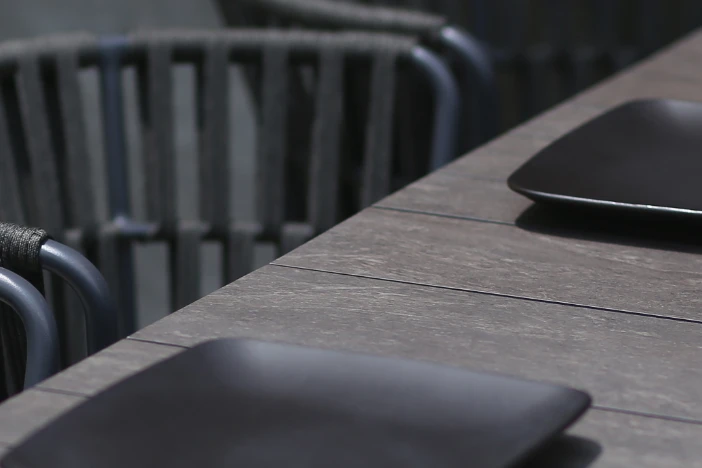
High-Pressure Laminate (HPL)
This composite is usually comprised of kraft paper that is impregnated with resin and aluminum and then heated under high pressure to create a layered contemporary material. HPL has a sleek look and is extremely hard, helping it resist stains and scratches. Melamine can be added to increase this laminate’s durability. It’s flame retardant and possesses antibacterial properties.
HPL made with pine kraft lignin is especially good for outdoor applications, as it has a low affinity for water which can cause swelling, internal stress and cracking [Ghorbani, Mahendran, van Herwijnen, Liebner & Konnerth 2017]. High-pressure laminate works well as an elegant tabletop for modern-styled outdoor dining and bistro tables, although it can be pricey relative to other material options.
PROS
- Sleek modern look
- Resists bacteria
- Impact-resistant
- Spill-resistant
CONS
- It can cost more than alternative materials
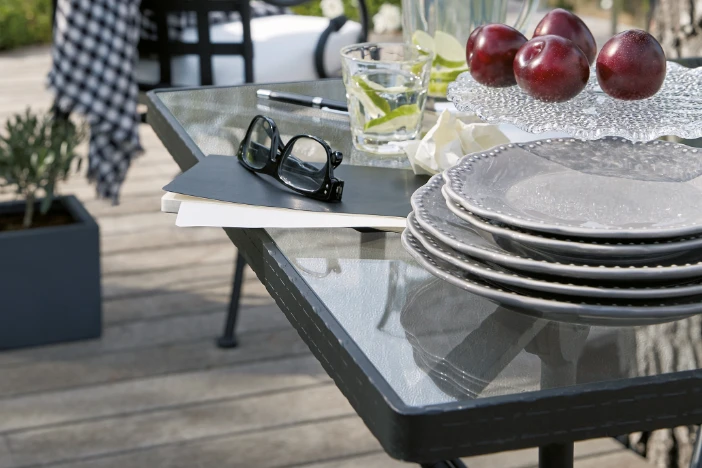
Tempered Glass
Tempered glass is often used for outdoor tabletops because of its resistance to temperature changes. Lacquering glass increases its protection against the effects of the elements, while acid washing inures it to smudges and fingerprints. Its smooth surface provides an elegant touch, while the clarity creates an open and airy feel.
Glass is a great choice for sunroom or screened-in porch dining and coffee tables, where there is some shade to prevent the sun from reflecting off it and blinding guests. Depending on the thickness, glass can be very heavy and hard to move.
PROS
- Resists temperature
- Looks elegant
CONS
- Can cause glare in sunny areas
- May be too heavy to move easily
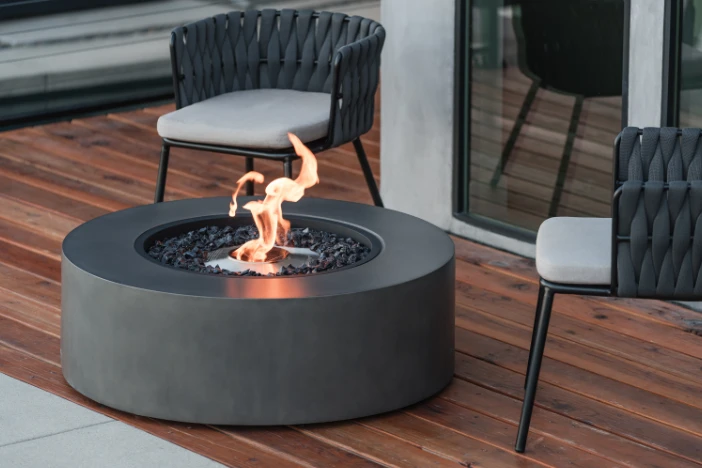
Concrete
While some minimalist modern environments may incorporate solid concrete outdoor furniture into their permanent design, this composite is more frequently employed in conjunction with other materials. It can serve as a sturdy base for glass-top dining and lounge tables, or as an imposing tabletop sitting upon a substantial metal frame.
Concrete is strong, timeless and can withstand the harshest elements for years. It can be poured into a variety of shapes and, when reinforced with fiber, molded into thinner constructions. Fibers may be comprised of glass, steel, synthetic or organic material and they increase the structural integrity of the concrete. It also helps the material withstand water and frost better.
PROS
- Long-lasting
- Strong
- Can take on many shapes
CONS
- It can be too heavy to move
- Stains
Concrete Composite (a.k.a. polymer concrete)
In recent years, compounds have been improved in response to the growing demand for atypically shaped furniture. Designers want the customization ability of concrete, but lighter, stronger and more resilient to the elements. Concrete composites are a blend of Portland cement and resin or fiberglass.
The resulting material has several advantages over traditional concrete:
- Strength – Some blends, such as Blinde Design’s Fluid™ Concrete, have up to 8 times the tensile strength of regular concrete
- Weight – Polymer concretes are lighter than normal concrete and, because they are also stronger, less is required to perform the same function
- Porosity – Concrete composite, unlike standard concrete, is non-porous so it resists stains, impact damage, scratches and cracking due to temperature changes
[Ali & Ansari 2013]
Designers can cast the material into virtually any shape with the look and feel of stone or concrete in a variety of colors. Owners benefit from furnishings made of fiber concrete because they are more portable and easier to clean than ordinary concrete versions. Additionally, concrete composite is a great option for fire tables and fire bowls that demand a sturdy non-flammable material that resists heating. The material may also be utilized for 3D printing.
Choosing Outdoor Furniture Materials
Choosing the right materials for outdoor furniture frames and tabletops is crucial for ensuring longevity, aesthetics and functionality in your outdoor living space. Resin and plastic stand out for their durability and ease of maintenance. These options are becoming even more popular due to innovations in manufacturing processes that offer a range of styles and designs that were once unattainable.
As you have learned throughout these chapters, it is important to keep the specific needs of your outdoor space in mind when selecting materials. Exposure to the elements, your desired aesthetic and maintenance preferences should all be considered alongside budget. While resin and plastic offer significant advantages, other materials like wood, metal and glass also bring unique benefits.
By understanding the characteristics and advantages of each material, you can make an informed decision that ensures your outdoor furniture not only looks great but also stands the test of time. Continue reading to learn more about the protective finishes and treatments that can enhance the longevity of your outdoor furniture.
References
- Topliff, C. R. (2018). USES AND INSTALLATION OF HDPE LINER TO REDUCE SOIL EROSION AND PREVENT WATER LOSS (Doctoral dissertation).
- Ghorbani, M., Mahendran, A. R., van Herwijnen, H. W., Liebner, F., & Konnerth, J. (2018). Based laminates produced with kraft lignin-rich phenol–formaldehyde resoles meet requirements for outdoor usage. European Journal of Wood and Wood Products, 76(2), 481-487.
- Ali, A., & Ansari, A. A. (2013, April). Polymer Concrete as Innovative Material for Development of Sustainable Architecture. In 2nd International Conference on Emerging Trends in Engineering & Technology. College of Engineering, Teerthanker Mahaveer University (pp. 1-4).

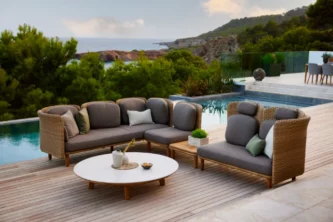
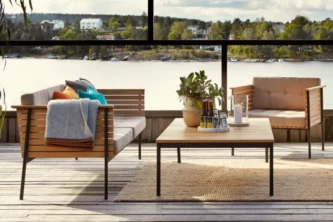
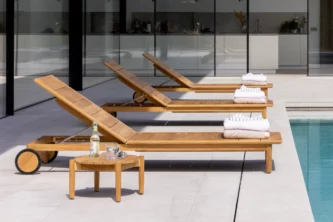
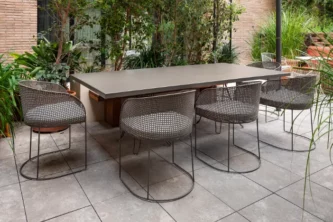
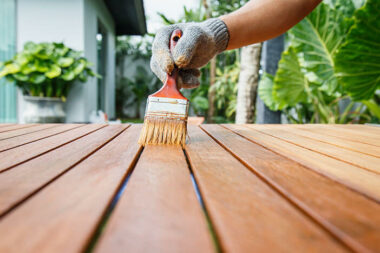
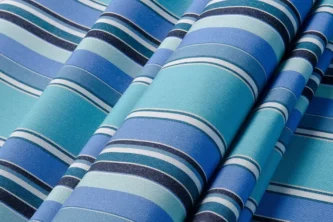
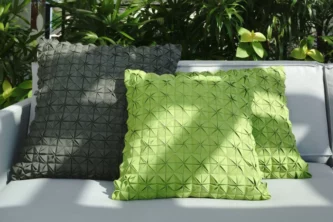
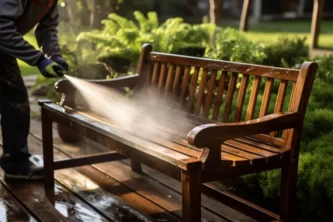








Leave a Reply